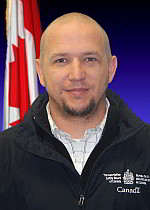Air transportation safety investigation A19O0028
This is the summary of a class 5 occurrence to which TSB investigators deployed. The investigation is now closed.
Table of contents
Collision with terrain
Cirrus SR20
Toronto/Buttonville Municipal Airport (CYKZ), Ontario
The occurrence
C-FACJ, a privately registered Cirrus SR20 aircraft, was rented by a commercially licensed pilot for the purpose of building flight time. As the pilot had limited experience on this aircraft type, in addition to no recent flying, the pilot hired an instructor to provide some training. The instructor was a Class 1 instructor, and a Transport Canada accredited Pilot Examiner.
On 12 March 2019 at 1342 Eastern Daylight Time (EDT), the aircraft departed from Runway 33 at Toronto/Buttonville Municipal (CYKZ), ON, with the commercial pilot and the instructor on board, with the intention to conduct some circuits at CYKZ. The wind was light and variable, so the aircraft joined the left downwind leg of the circuit for Runway 33, and planned for a touch-and-go.
At 1348 EDT on the initial touchdown, the aircraft bounced and full power was added to commence the takeoff portion of the touch-and-go. The nose of the aircraft was raised, the aircraft became briefly airborne, before returning to the surface abruptly. The nose was raised again, and the tail of the aircraft struck the runway as the aircraft became airborne again, albeit briefly. As the aircraft contacted the ground the third time, the outer right flap hinge and right wheel contacted the ground outside of the runway surface laterally, approximately 1000 feet from the runway end. The nose was raised again, and the aircraft continued the take-off roll on the ground, beyond the end of the runway, then struck a 4-foot-high fence, located 60 feet past the runway end. Past this fence, the terrain slopes down toward 16th Avenue, which crosses the departure path perpendicularly. The aircraft crossed 16th Avenue in the air, in a right bank, and dragging the right wing tip. The aircraft passed directly in front of a tow truck that was in the westbound lane, and the driver of the vehicle captured the event on dash-camera. North of 16th Avenue, the terrain rises rapidly; the aircraft collided with the ground, and came to a stop approximately 250 feet past the end of Runway 33. The two occupants were wearing 4-point safety belts and received no significant injuries. The aircraft received significant damage to the wings, nose, tail, landing gear, and propeller.
The aircraft was equipped with an Avidyne FlightMax Entegra flight display that recorded engine and GPS data. The unit recorded one data point every 6 seconds. This data was acquired and analyzed by the TSB following the accident. It was noticed that, following the initial touchdown on Runway 33, the engine RPM and manifold pressure increased to full, followed by a significant reduction, and then a return to full. During the touch-and-go attempt, the recorded ground speed steadily decreased from 61 kts at the initial touchdown point, to 52 kts shortly before impact.
Media materials
Deployment notice
TSB is deploying an investigator to the site of a runway excursion at the Toronto/Buttonville Municipal Airport, Ontario
The Transportation Safety Board of Canada (TSB) is deploying an investigator to a runway excursion of a small aircraft at the Toronto/Buttonville Municipal Airport, Ontario. The TSB will gather information and assess the occurrence.
Investigation information
Map showing the location of the occurrence
Investigator-in-Charge

Ewan Tasker has over 25 years of civil aviation experience. He joined the TSB in 2008 and is now the Manager of International Operations and Major Investigations, based out of Richmond Hill, Ontario. Since joining the TSB, he has participated in numerous investigations, as both an operational team member and investigator-in-charge.
Before joining the TSB, Mr. Tasker flew commercially throughout North America and South America, accrued over 7000 hours of flight time, and obtained airline transport pilot licences from three different regulatory bodies. During his “from-the-ground-up” career, he has worked every position, from baggage handler to chief pilot. Mr. Tasker is also a Transport Canada–licensed air traffic controller.
Photos
Download high-resolution photos from the TSB Flickr page.
Class of investigation
This is a class 5 investigation. Class 5 investigations are limited to collecting data, which are then stored in the modal database. If TSB investigators deployed to the occurrence site, a short description of the occurrence is posted to the TSB website once the investigation has been completed. These investigations are generally completed within 90 days. For more information, see the Policy on Occurrence Classification.
TSB investigation process
There are 3 phases to a TSB investigation
- Field phase: a team of investigators examines the occurrence site and wreckage, interviews witnesses and collects pertinent information.
- Examination and analysis phase: the TSB reviews pertinent records, tests components of the wreckage in the lab, determines the sequence of events and identifies safety deficiencies. When safety deficiencies are suspected or confirmed, the TSB advises the appropriate authority without waiting until publication of the final report.
- Report phase: a confidential draft report is approved by the Board and sent to persons and corporations who are directly concerned by the report. They then have the opportunity to dispute or correct information they believe to be incorrect. The Board considers all representations before approving the final report, which is subsequently released to the public.
For more information, see our Investigation process page.
The TSB is an independent agency that investigates air, marine, pipeline, and rail transportation occurrences. Its sole aim is the advancement of transportation safety. It is not the function of the Board to assign fault or determine civil or criminal liability.
